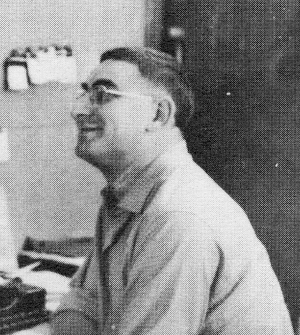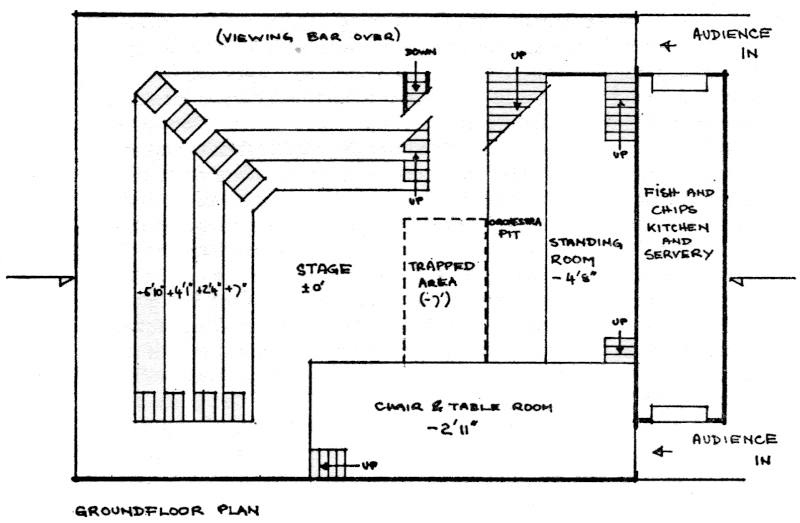Stephen Joseph's 'Fish & Chip Theatre'
Over the course of his professional life, Stephen Joseph was responsible for a number of innovative and ground-breaking theatre designs and ideas such as his work on theatre in the round in Scarborough and Stoke as well as other designs whilst working with the Society of Theatre Consultants.
Stephen Joseph
(© Studio Theatre Ltd)
Stephen Joseph
It was an innovative design which was predicated on the two elements which Stephen believed were the most essential in theatre, actor and audience. It was technologically ahead of its time and probably couldn't have been realised in the mid 1960s and it was also predicated on the democratisation of theatre.
Stephen genuinely and earnestly wanted to break down audience barriers in the theatre and make it as appealing and accessible to as wide an audience as possible. He believed working class audiences were traditionally ill-served by theatre in either price or approach - they were not welcoming to working class audiences. Stephen's work with theatre in the round had already proved a success in breaking through some of these boundaries, but 'Fish and Chip Theatre' was to take it a step further.
Accessible with options to sit or stand or eat a fish and chip supper whilst watching the show. A bar / lounge would have had a live feed to the stage so those wanting to have a drink could still watch the play. Every aspect was made to emphasise the comfort and freedom of the audience.
Stephen spoke about this idea extensively in Scarborough during the early 1960s, probably in post-show discussions at Theatre in the Round at the Library Theatre but also in talks and lectures. For something he wrote very little about, the concept was remarkably well-known in Scarborough for many years afterwards, indicating Stephen had frequently talked with passion and enthusiasm about the project.
There are two extant sets of plans for the 'Fish & Chip Theatre'. One is held in the Stephen Joseph Collection in the John Roland's Library at the University of Manchester. The other was held by Alan Ayckbourn until 2023, when he donated it to Scarborough Museums and Galleries as part of The Ayckbourn Collection. The idea which Stephen has envisioned for Scarborough finally find ing a home within the town.
This is Stephen Joseph's description of the 'Fish & Chip Theatre' from his book Theatre in the Round (1967, Barrie & Rockliffe) as well as the simplified ground floor plan he included with the text.
Extract from Theatre in the Round by Stephen Joseph
"A slightly more prosaic but, in its way, I hope, still exciting theatre that would also be interesting to work in is my Fish and Chip Theatre, originally conceived for Scarborough. The architect’s brief is to build a theatre in the round, accommodating about 400 people.
"In addition to the information given for Theatre Two, our special requirements include a rectangular stage that, taken as datum level, has rising seating rows on two sides, a low standing room pit on the third side, and a dining room level on the fourth. All around the theatre, at (or above) the level of the back row, there is a viewing bar, arranged so that you can sit for a drink and snack and watch the play at the same time.
"Kitchens and serveries and bars to be provided, offering a limited range of refreshments, including fish and chips, soup and rolls, salad bowls, buns, cakes, biscuits, fruit, nuts, ice-cream, beer, coffee, tea, soft-drinks, and wines. Serve yourself at the counter.
"All sections of the auditorium should be organically connected to encourage free flow of audience from one place to another, even during the performance. The design should be asymmetrical, and invite movement. The seats should be generously spaced. Proportions so related to human stature that the actors and audience dominate the building and not the other way round.
"Noise problems? Yes, but the science of acoustics exists and can cope with everything we are likely to demand. Floor, wall and ceiling treatments must be sensibly chosen. The viewing bar should be a good rowdy place, and therefore acoustically separated from the main auditorium with viewing facilities through a restricted opening - and sound reinforcement from the stage through a series of loud- speakers, locally controlled; plug jacks for headphones which may help deaf people and the occasional attentive person on a particularly noisy pay-day performance.
"The stage should be provided with traps, an orchestra pit and a balcony acting area. Comfortable dressing rooms with showers and divans for resting: the actors will need them."

Stephen Joseph's design for the 'Fish & Chip Theatre' reproduced in Theatre in the Round (1967, Barrie & Rockliffe). This is the ground floor, the plans held in Manchester and Scarborough also include a gallery plan with a viewing area and bar / lounge with audio / visual equipment.
Article by and copyright of Simon Murgatroyd. Extract and illustration copyright of Stephen Joseph. Please do no reproduce without permission of the copyright holder.
Article by and copyright of Simon Murgatroyd. Extract and illustration copyright of Stephen Joseph. Please do no reproduce without permission of the copyright holder.